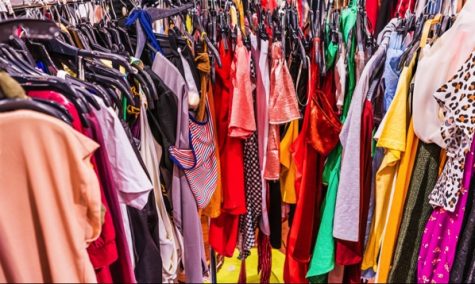Is Fast Fashion Really Economical?

Human nature is such that we usually tend to render our actions as “correct.” Fast fashion is no exception. Shoppers are enthralled by the promise of quick, cheap, and fashionable clothes at the tap of a finger. In fact, 88% of clothing consumers in the USA shop fast fashion instead of buying higher quality, environmentally friendly garments. Fashion trends are highly unpredictable, as they are influenced by factors such as social media, celebrity endorsements, marketing, and sales. Following these trends give consumers the power to feel relevant in the fast-footed society of today. However, fast fashion can lead to multiple different environmental crises. Fast fashion is made so that clothes take a short amount of time to produce but then wear off after a couple of wears. Articles of clothing that are manufactured specifically for the fast fashion industry carry many problems that can lead the customer to dispose of them, including being easily worn out, tearable, fade-prone material, and defective due to mass-manufacturing error.
Despite its drawbacks, Fast fashion has risen to one of the top priorities of brands such as H&M, a Swedish fast fashion giant, and to organizations, such as the French Fashion Federation, which host France’s famous Paris Fashion Week. However, some companies market themselves as eco-friendly environment savers, when they are really using marketing tactics to enthrall potential customers. H&M markets itself as eco-friendly by using the following tactic: trading out old, damaged clothing earns a 15% coupon towards a consumer’s next purchase on an article of clothing! H&M’s approach here is to illusion the buyer into thinking that they are getting rid of clothes with a benefit. H&M’s real goal, however, is to make potential customers walk out with even more fast fashion-produced clothes.
 Another famous fast fashion company is Zara, based in Galicia, Spain. It’s known for selling moderately priced garments of clothing that always seem to be in style. To accomplish this, Zara uses a technique that most of its other competitors do not use: they produce their clothing during the current season instead of forecasting what the next style will be. By doing this, Zara saves more materials and avoids overproducing clothing, leaving its competitors stuck with thousands of garments from previous seasons. These clothes don’t sell, leaving their vendors only two options—to dispose of them or to recycle them and produce more clothing. However, the second option is significantly pricier, and companies tend to lean towards saving money. Another factor that helps Zara get ahead in the fast fashion market is its production speed. Zara changes its fashions every couple of weeks, significantly overshadowing the production speed of its competitors. The secret to its success as a fast fashion brand lies in its headquarters, known as “The Cube.” In the Cube, three major processes happen: design, manufacturing, and distribution. The Cube has underground railroads that take clothes directly to eleven Zara stores, eliminating a large part of transporting the clothing.
Another famous fast fashion company is Zara, based in Galicia, Spain. It’s known for selling moderately priced garments of clothing that always seem to be in style. To accomplish this, Zara uses a technique that most of its other competitors do not use: they produce their clothing during the current season instead of forecasting what the next style will be. By doing this, Zara saves more materials and avoids overproducing clothing, leaving its competitors stuck with thousands of garments from previous seasons. These clothes don’t sell, leaving their vendors only two options—to dispose of them or to recycle them and produce more clothing. However, the second option is significantly pricier, and companies tend to lean towards saving money. Another factor that helps Zara get ahead in the fast fashion market is its production speed. Zara changes its fashions every couple of weeks, significantly overshadowing the production speed of its competitors. The secret to its success as a fast fashion brand lies in its headquarters, known as “The Cube.” In the Cube, three major processes happen: design, manufacturing, and distribution. The Cube has underground railroads that take clothes directly to eleven Zara stores, eliminating a large part of transporting the clothing.
Brands are rushing to utilize the technology that allows them to produce clothing faster than ever. Originally, there were two fashion seasons per brand a year. Now, due to massive boosts in manufacturing, resources, and technology, there are 52 micro-seasons dispersed throughout the year. Due to this, brands now produce 400% more articles of clothing than just a fifth of a century ago. The amount of clothing that we are producing is not a big problem alone—it’s what goes into the clothing that makes fast fashion a problem. For every one kilogram of cotton used in clothing, 10,000 liters of freshwater are used to process it. After treating the cotton, the water is untreatable and has to be disposed of. This wastewater contains traces of multiple dangerous elements that pose threats to wildlife and humans alike—arsenic, lead, mercury, and so on. Drinking the wastewater can result in cancer, death, brain damage, anemia, and hallucinations which can lead to suicide. On Earth, there are around 335,000,000 cubic miles of water. Of that water, 2.507% is freshwater. Of that, around ⅓ is drinkable and the rest is solid ice. If companies are constantly transforming our freshwater into undrinkable chemical compounds, the demand for freshwater will skyrocket, accelerating processes of global warming and world hunger.
Another problem with fast fashion is the cheap materials used to produce it. Materials used in fast fashion are often synthetic plastic fibers that cause major CO2 emissions. If these clothes are not disposed of properly, they could end up in the ocean, not degrading for over a century. One such fiber is viscose, a synthetic fabric used extensively in the fashion industry. Its effects on the environment are brutal—it doesn’t decompose for long amounts of time, is unburnable due to large amounts of toxic gasses being released upon the burn of the fabric, and causes environmental damage when created. Fast fashion acts as a catalyst towards the process of making rayon, causing even more destruction.
 Sadly, the effects of fast fashion don’t just stop at environmental damage. Manual labor is used to construct any garment of clothing. However, more often than not, this manual labor is not ethically sourced in fast fashion businesses. Also, more often than not, this labor is conducted by children or minors. Since the supply and demand is so high for cheap, fashionable garments, businesses are always looking for cheap ways to produce their clothes. The top way? Child labor. Children are able to adapt to situations easier and usually don’t act out against their employers, making them the perfect candidates for labor. In a case in India, young women spinning cotton in textile factories were exploited by their employers because of the shape of their fingers. As described by the India Committee of the Netherlands, “[i]n 2007, more than 400,000 children under the age of 18 were found to be employed in cottonseed farms in the Indian states of Gujarat, Andhra Pradesh, Tamil Nadu and Karnataka. More than half of these children were younger than fourteen. These farms account for more than ninety per cent of the total production area in India.” These girls were employed to work longer hours and also were content with being paid below the minimum wage.
Sadly, the effects of fast fashion don’t just stop at environmental damage. Manual labor is used to construct any garment of clothing. However, more often than not, this manual labor is not ethically sourced in fast fashion businesses. Also, more often than not, this labor is conducted by children or minors. Since the supply and demand is so high for cheap, fashionable garments, businesses are always looking for cheap ways to produce their clothes. The top way? Child labor. Children are able to adapt to situations easier and usually don’t act out against their employers, making them the perfect candidates for labor. In a case in India, young women spinning cotton in textile factories were exploited by their employers because of the shape of their fingers. As described by the India Committee of the Netherlands, “[i]n 2007, more than 400,000 children under the age of 18 were found to be employed in cottonseed farms in the Indian states of Gujarat, Andhra Pradesh, Tamil Nadu and Karnataka. More than half of these children were younger than fourteen. These farms account for more than ninety per cent of the total production area in India.” These girls were employed to work longer hours and also were content with being paid below the minimum wage.
These problems aren’t just secrets that exist deep below the eyes of the public. Some governments don’t hesitate to share information about their investments in child labor.For example, the Uzbek government forces children as young as 9 years old to skip school to help with the yearly cotton harvest. During this time period, the children live in cramped barracks with no heating or insulation and often receive no pay. If children don’t pick a satisfactory amount of cotton, they’re often threatened by the school boards with either expulsion or bad grades.
Overall, fast fashion hurts the environment and people alike. The diverse effects of the production of fast fashion are nothing to be overlooked, and one day might affect the environment– and we won’t be able to fix it.

Aarav Gedala is a junior at Keystone School who is interested in writing about a variety of topics, including fashion and health.
